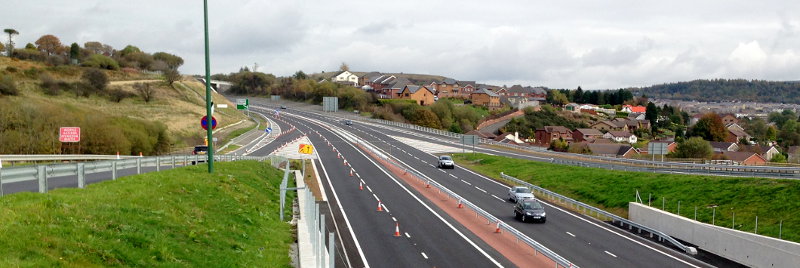With the most unsuitable section of the A465 replaced by a new road, without steep hills or sharp corners, suddenly the Abergavenny to Hirwaun section of the route between Swansea and the Midlands was the best part. It was the remaining sections that were now a problem.
The Ministry of Transport began investigating its options for improving the road from Hirwaun to Swansea, and in the other direction, from Abergavenny towards the M50.
The worst stretch was from Hirwaun to the A48 Neath Bypass, but rising traffic levels meant that this section of road now justified a dual carriageway with grade-separated junctions. Work began on two sections in the early 1970s, and by 1975 there was a new expressway from the Hirwaun to Glyn-Neath, and then from Aberdulais to the A48, replacing two-thirds of the old road. The route was supposed to be completed with a further new road from Glyn-Neath to Aberdulais by about 1980, but the financial crisis of the mid-1970s caused it to fall further and further down the priority list until it vanished completely.
In 1980, the first EU rebate negotiated by the new Conservative government was used to fund a new road at the other end of the route — the A40 between Raglan and Abergavenny was replaced by almost twelve miles (19 km) of dual carriageway paid for by Brussels. But despite pressure from Welsh MPs, no further investment — or interest — seemed to be forthcoming from the Department of Transport.
It was in 1994 that the Heads of the Valleys Road entered a new era. John Redwood, Secretary of State for Wales, announced that the A465 Heads of the Valleys Road was to be one of the three major arteries serving Wales, the other two being the M4 and A55, and that it would therefore be transformed into a high-standard dual carriageway. To show he meant business, he found money to pay for the missing link between Glyn-Neath and Aberdulais, and announced that he had asked for dualling the 1960s road from Abergavenny to Hirwaun to be accelerated.
"Progress now depends on the speed of design work, consultation and statutory procedures. I see the A465 bringing prosperity to the northern valleys as surely as the M4 is doing in the south."
The acceleration he wanted might not have been as rapid as it could have been, and the statutory procedures took several years to complete. But the Heads of the Valleys upgrade survived not just a change of government in 1997, but also devolution and the creation of the Welsh Assembly. Today, the Assembly attaches the same high importance to the A465, and since the early 2000s has poured considerable resources into its transformation from the three-lane road of the 1960s to a high-speed expressway.
Picking up speed
Unlike the original 1960s scheme, the upgrade of the same 25 miles of road from Abergavenny to Hirwaun is now happening in six stages, and will cost considerably more than the original £7.2m.
| Section | Start of work | Completion | Cost | |
|---|---|---|---|---|
| 1 | Abergavenny — Gilwern | 2005 | 2008 | £60m |
| 2 | Gilwern — Brynmawr (Clydach Gorge) | 2014 | 2022 (originally due 2017) | £197.5m |
| 3 | Brynmawr — Tredegar | 2013 | 2015 | £168m |
| 4 | Tredegar — Dowlais Top | 2002 | 2004 | £47m |
| 5 | Dowlais Top — Hirwaun | 2021 | 2025 | £590m |
In summer 2025, work was finally completed on the final upgrade project, sections 5 and 6 combined, a complex scheme passing through the northern suburbs of Merthyr Tydfil and involving huge amounts of new bridgework.
The latter years of the project saw the Welsh Government coming under increasing pressure to justify the roadworks — amid claims that 30% of people in this part of Wales don't even own a car, and that the traffic levels on the Heads of the Valleys Road don't justify an expensive new dual carriageway. The counter-argument is that the safety of the three-lane road was doubtful even when it was first built in the early 1960s, and the A465 had developed a definite safety problem. Building a safer road for the heavy traffic that uses it is a better solution than trying to adapt the present substandard road.
Whatever the criticism, the Welsh Assembly completed its new expressway. It was the final big project to be approved before the complete halt on new road projects that is now in force across Wales, so it may also be the last major new road to be built there. If so, it is quite a final flourish.
The part that proved most difficult in 1960, the Clydach Gorge, saw teams of twenty first century contractors and workmen spend eight years shifting earth and blasting rock in an attempt to carve out space for an even wider road. It was finally done after an overrun of almost five years. The contractor, Costain, might have done well to look back at the situation John Morgan's company found themselves in all those years ago, and learn the lesson that the Heads of the Valleys is not an easy place to build a road at all.




